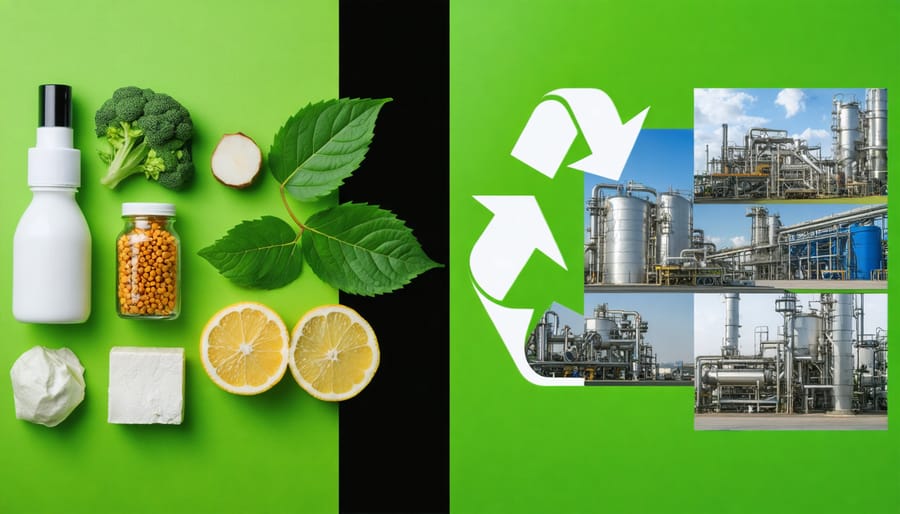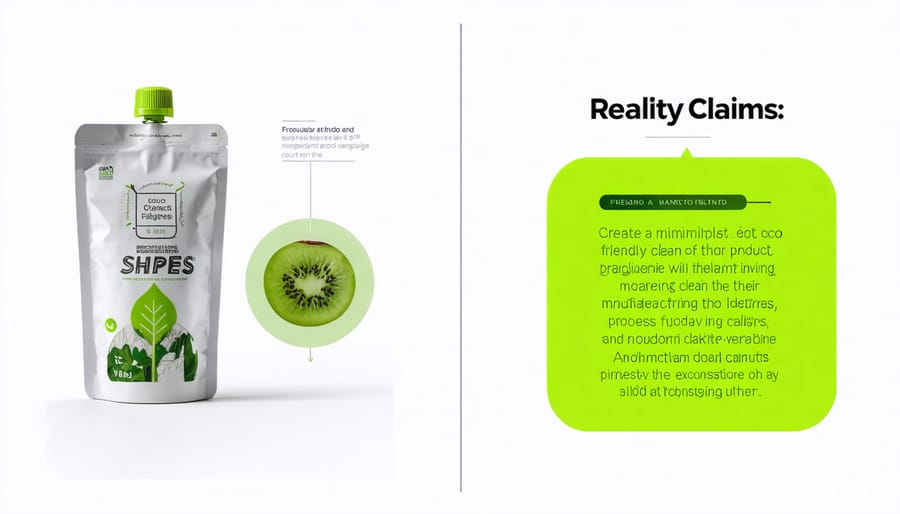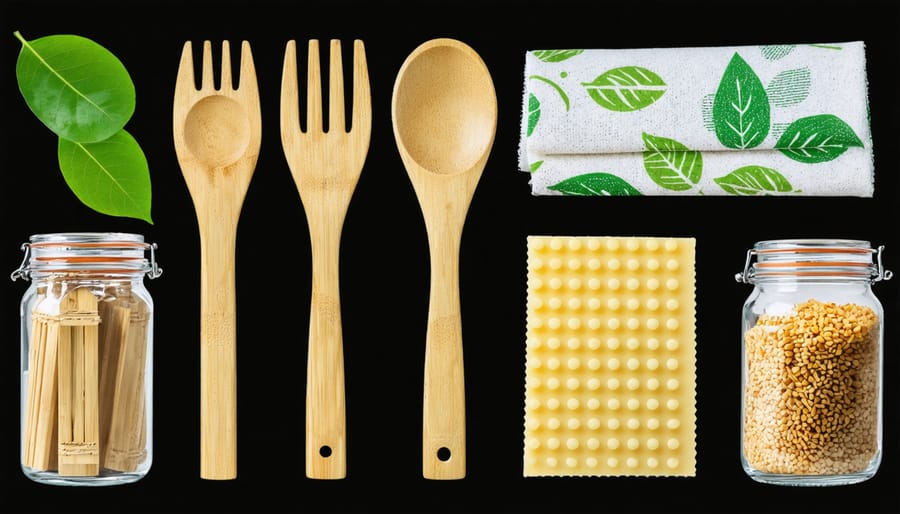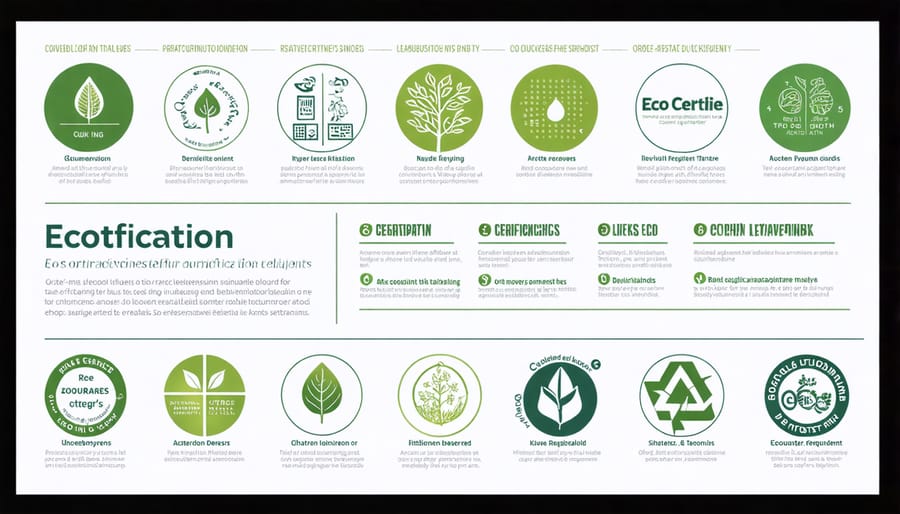
Standing in the eco-friendly aisle of your local store, bamboo toothbrushes and recycled packaging catch your eye – but are these “green” products truly as earth-friendly as they claim? As someone who’s spent years navigating the complex world of sustainable shopping, I’ve learned that the answer isn’t always as clear-cut as the marketing would have us believe.
The global eco-friendly product market has exploded to over $300 billion, yet studies suggest that up to 40% of “green” claims may be misleading or unsubstantiated. From biodegradable plastics that don’t actually break down in landfills to “natural” beauty products packed with hidden synthetic ingredients, the gap between perception and reality can be startling.
But before you throw in the reusable towel, there’s hope. Understanding the true environmental impact of our purchases doesn’t require a science degree – just a healthy dose of skepticism and some practical knowledge. Whether you’re a seasoned eco-warrior or just starting your sustainability journey, this guide will help you navigate the sometimes murky waters of eco-friendly products, separate genuine environmental solutions from clever marketing tactics, and make choices that truly benefit our planet.
Let’s peel back the layers of green marketing and discover what really makes a product environmentally responsible – and what’s just greenwashing in disguise.
When Green Marketing Isn’t So Green
Common Misleading Claims
Ever notice how everything seems to be “green” or “eco-friendly” these days? As someone who used to grab anything with a leaf symbol, I’ve learned that not all environmental claims are what they seem. Let’s decode some common marketing terms that might be misleading us.
“Natural” is probably the trickiest term out there – it sounds great, but it actually has no regulated definition. A product can contain mostly synthetic ingredients and still use this label! Similarly, “chemical-free” is technically impossible since everything, including water, is a chemical.
“Biodegradable” is another tricky one. While it sounds promising, without specific timeframes or conditions, a product could take decades to break down. Even then, it might leave behind harmful residues.
“Recyclable” doesn’t always mean what we think either. Just because a package has that familiar triangle symbol doesn’t guarantee your local facility can process it. And “compostable”? Unless specifically marked as home-compostable, most items need industrial facilities to break down properly.
One of my personal favorites is “eco-friendly packaging” – sometimes it just means they’ve made the plastic bottle slightly thinner! Remember, marketing terms are designed to sell, so it’s worth diving deeper than the label.

Hidden Environmental Costs
When I started looking beyond the “eco-friendly” labels on my favorite products, I discovered some eye-opening truths about their manufacturing processes. While a bamboo toothbrush might seem like an obvious environmental win, its journey from raw material to your bathroom cabinet often involves significant environmental costs that aren’t immediately apparent.
Many eco-friendly products require intensive processing methods that consume substantial energy and water. For instance, transforming bamboo into soft fabric involves chemical treatments and high-energy manufacturing processes. Similarly, the production of recycled plastic products often requires additional cleaning and processing steps, potentially creating a larger carbon footprint than expected.
Transportation is another hidden factor we rarely consider. That organic cotton tote bag might travel thousands of miles before reaching your local store, accumulating quite a carbon footprint along the way. Even products made from sustainable materials can have complex supply chains involving multiple countries and transportation methods.
Water usage is particularly concerning – some “natural” textile processing can require thousands of gallons of water, even for small batches. While the end product might be biodegradable, the resources used in its creation could offset its environmental benefits.
Let’s be clear – this doesn’t mean eco-friendly products aren’t worth buying. Rather, it’s about being aware and making informed choices.
Popular Eco-Products Under the Microscope

Kitchen and Food Storage
The kitchen is often our first stop when transitioning to eco-friendly alternatives, but let’s take a closer look at some popular sustainable swaps. I remember being thrilled when I first discovered bamboo utensils – they seemed like the perfect solution to plastic cutlery. While bamboo is indeed renewable and biodegradable, not all bamboo products are created equal. Many are treated with chemicals or mixed with melamine resins to increase durability, potentially compromising their eco-friendly status.
Beeswax wraps have become a trendy replacement for plastic wrap, and I’ve been using them in my kitchen for the past two years. They’re genuinely sustainable when made with organic cotton and natural beeswax, but some manufacturers add synthetic additives that can reduce their biodegradability. The good news? When properly cared for, quality beeswax wraps can last up to a year and can be completely composted at the end of their life.
The biodegradable packaging trend has exploded recently, but this is where things get tricky. While many products claim to be biodegradable, they often require specific industrial conditions to break down properly. I learned this the hard way after discovering that my “biodegradable” storage containers weren’t breaking down in my home compost bin.
To make truly eco-friendly choices in the kitchen, look for products with transparent manufacturing processes and clear end-of-life instructions. Opt for bamboo items certified by reputable organizations, choose beeswax wraps from small-batch producers who use natural ingredients, and be skeptical of vague biodegradability claims. Sometimes, the most sustainable choice might be using what you already have until it needs replacing, rather than rushing to buy new “eco” alternatives.
Consider durability alongside sustainability – a well-made stainless steel utensil that lasts decades might be more environmentally friendly than a bamboo alternative that needs replacing every few years. Remember, the most eco-friendly product is often the one that’s both sustainably produced and built to last.
Beauty and Personal Care
When it comes to beauty and personal care, the promise of eco-friendly products can be as complex as your favorite moisturizer’s ingredient list. Many eco-friendly beauty brands tout sustainable packaging and natural ingredients, but let’s look beneath the surface of these green claims.
I recently switched to a sustainable skincare routine, and while glass bottles and bamboo packaging look beautiful on my bathroom shelf, I’ve learned that appearances can be deceiving. Glass, while recyclable, requires more energy to transport due to its weight, potentially increasing the carbon footprint. Bamboo packaging, though renewable, often involves intensive processing and may contain hidden plastic components.
Natural ingredients aren’t automatically better for the environment either. Take palm oil, a common ingredient in “eco-friendly” cosmetics – its production is a leading cause of deforestation. Similarly, organic aloe vera farming can strain water resources in drought-prone regions. Even seemingly innocent ingredients like glitter in “natural” makeup often contain microplastics that harm marine life.
However, this doesn’t mean all green beauty claims are false. Many brands are making genuine strides toward sustainability. Look for products with minimal packaging, locally sourced ingredients, and transparent supply chains. Refillable containers are gaining popularity, and some companies now offer take-back programs for their packaging.
The key is to focus on products that align with your specific needs while considering their entire lifecycle impact. Sometimes, a product with synthetic ingredients but minimal packaging might have a lower environmental impact than an “all-natural” option in excessive packaging. Remember, the most sustainable product is often the one you already own and use completely.
Consider starting small – perhaps with multi-purpose products that reduce the number of items you need, or by supporting brands that prioritize both environmental responsibility and effectiveness. The beauty industry is evolving, and our choices as consumers help shape its direction toward genuine sustainability.
Making Genuinely Sustainable Choices

Research Before You Buy
Like many of you, I’ve fallen for clever marketing claims only to later discover they weren’t quite what they seemed. That’s why I’ve learned to become a savvy eco-conscious shopper, and I’m excited to share some practical tips to help you do the same.
First, familiarize yourself with common environmental certifications. Look for well-established labels like USDA Organic, Energy Star, and Forest Stewardship Council (FSC). These certifications undergo rigorous third-party verification processes, making them more reliable than vague claims like “natural” or “eco-friendly.”
When evaluating a product, consider its entire lifecycle. What materials is it made from? How is it manufactured? What happens when you’re done with it? A truly eco-friendly product should have minimal environmental impact at every stage.
Don’t be shy about doing your homework. Visit the brand’s website and look for detailed information about their sustainability practices. Genuine eco-friendly companies typically provide transparent information about their manufacturing processes, materials sourcing, and environmental initiatives.
Be wary of buzzwords without substance. Terms like “green,” “biodegradable,” and “sustainable” aren’t regulated, so companies can use them freely. Instead, look for specific, measurable claims backed by data or certifications.
Remember, social media can be your friend here. Follow environmental advocacy groups and sustainable living communities. They often share valuable insights about which brands truly walk the talk when it comes to environmental responsibility.
Better Alternatives
Let’s explore some genuinely sustainable options that go beyond the marketing hype. First, consider embracing a “less is more” approach – the most eco-friendly product is often the one you don’t buy at all. Instead of purchasing new containers, try reusing what you already have. Mason jars make excellent storage solutions, and old t-shirts can become cleaning rags.
When shopping is necessary, look for products with minimal packaging or, better yet, no packaging at all. Many local shops now offer refill stations for cleaning supplies and personal care items. These allow you to reuse containers while accessing high-quality, environmentally conscious products.
For beauty and skincare, exploring sustainable beauty practices can make a significant impact. Consider switching to solid shampoo bars, reusable cotton rounds, and plastic-free packaging options. You might be surprised by how many natural alternatives work just as well as their conventional counterparts.
In the kitchen, opt for durable, long-lasting items made from sustainable materials like bamboo or stainless steel. Instead of single-use products, invest in quality items that can be repaired rather than replaced. Shopping at local farmers’ markets with your own bags and containers reduces packaging waste while supporting local businesses.
Remember, truly sustainable choices often involve changing habits rather than just switching products. Simple actions like meal planning to reduce food waste, composting, and borrowing rarely-used items from neighbors can have a more significant environmental impact than purchasing “eco-friendly” alternatives.
As we navigate the complex world of eco-friendly products, it’s clear that being a conscious consumer requires more than just reaching for items labeled “green” or “sustainable.” The journey toward genuine environmental responsibility starts with us – making informed decisions and understanding that every purchase has an impact.
I’ve learned through my own sustainability journey that the most eco-friendly choice is often the simplest one: buying less and using what we already have. When we do need to make purchases, taking time to research brands, understanding certifications, and looking beyond marketing claims can help us make truly sustainable choices.
Remember, perfection isn’t the goal – progress is. Start small by making mindful choices in areas that matter most to you, whether that’s kitchen essentials, beauty products, or household cleaners. Consider the full lifecycle of products, from production to disposal, and support companies that demonstrate genuine commitment to environmental stewardship.
Let’s embrace our power as consumers to drive positive change. By sharing our knowledge with friends and family, supporting truly sustainable brands, and being vocal about our expectations for environmental responsibility, we can collectively push for better practices in the industry.
The path to sustainability isn’t always straightforward, but by staying informed and making conscious choices, we can all contribute to a healthier planet – one purchase at a time.



